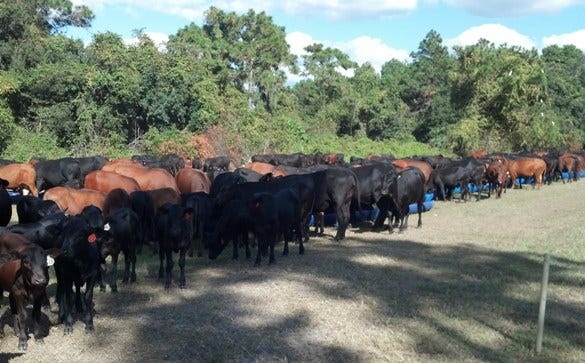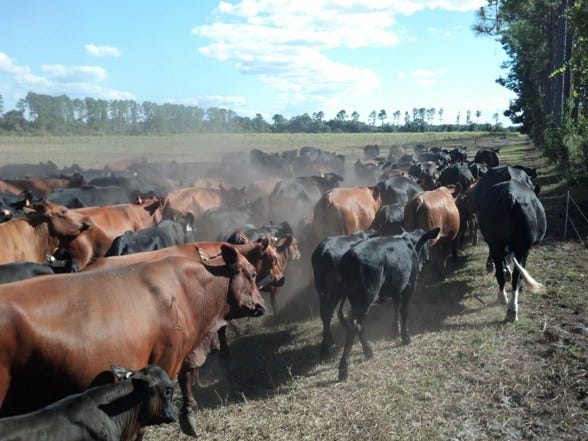November 20, 2014

We have recently moved from grazing our pasture crops to grazing stockpiled forages and adding a protein supplement.
I've written about this before, but I'll reiterate that the purpose of non-selective grazing and multiple moves on stockpiled grass is to save money by avoiding hay feeding, which normally is a very big expense in Florida and often in other locations.
This year, we started the dormant season by grazing planted, annual pasture crops. This was to build the soil and provide some high-quality grazing at a time we normally have only moderate quality. By doing this we should require less of the stockpiled Bahia grass, which needs to be supplemented with protein as when old and frosted. In winter Bahia is very low in protein.

All 450 cattle are eating protein supplement from the barrel feeders before moving to a new break in the afternoon.
I haven't had success with moving cows to a high protein forage and then back to low-protein old forage on a daily basis, so I prefer to finish the higher quality forage first as it will lose quality the fastest.
I start grazing the stockpile when we run out of grass on the growing season grazing part of the ranch, then start grazing the stockpile with the end in mind.
When I started on stockpiled forage I was giving them was 1.5 acres in a paddock, three times a day for a total of 4.5 acres per day. This is done with electric poly wire. Frequent moves maintain an even plane of nutrition and improve harvest efficiency.

Here the cattle have finished the protein supplement and are headed for their last forage break of the day.
After a few days of doing this you know how much area your herd requires per day and can plan how many days of stockpile you have left to manage accordingly.
Then watch manure, gut fill and body condition to determine if they need protein and/or Cornerpost. Cornerpost, which is a product from Free Choice Enterprises, will save around 25-30% of forage due to more efficient fiber digestion and it's a tool to use when needed.
I have done these things and adjusted my winter feeding this way: I lowered the flaxseed meal from 16 bags to 12 and I mix in six bags of dry Cornerpost. I also am now giving them three acres per day instead of 4.5 acres. Their body condition, manure and fill have improved.
That is a 33% smaller area with a better nutritional result and it costs around 25 cents per cow per day. It allows me to avoid hay later in the season, which would cost $1.50 per head. Besides getting better body condition, the cows stop consuming minerals when I feed the Cornerpost.
The end purpose is to not use any hay and still have good animal performance. This will depend on your environment. If the worst scenario is 270 days of non-growth then I have to divide the stockpiled area in such a manner that allows me to feed all the cattle for 270 days. Then I will subdivide the daily allotment in four to six breaks per day to keep animal performance at a higher level.
Protein supplement needs depend on forage quality, including the protein and fiber content.
The pictures in this blog show the cows at portable feed troughs and then leaving for the fresh break. I've written in a previous blog about how I build these.
I now have 450 total animals, including calves. That requires 16 feed-trough trains, each one with 12 half plastic barrels. I am feeding at the moment 600 pounds of linseed meal per day and the cows are improving body condition. Grass utilization efficiency is high.
At 7:30 a.m. the cattle get the first break of about one acre to graze non-selectively. At 11 a.m. they get a second break and I put the linseed meal at the feed troughs. At 3 p.m. I call them to the feed troughs and close the gate when they are in so I can go and open the third break of pasture. After they finish the linseed meal, which takes about 10 minutes, I open the gate and call them so they go to the fresh break.
This way they don't step on me when I am feeding and it's easier for all.
If I was feeding range cubes it would be much easier but maybe not as cost effective.
About the Author(s)
You May Also Like




